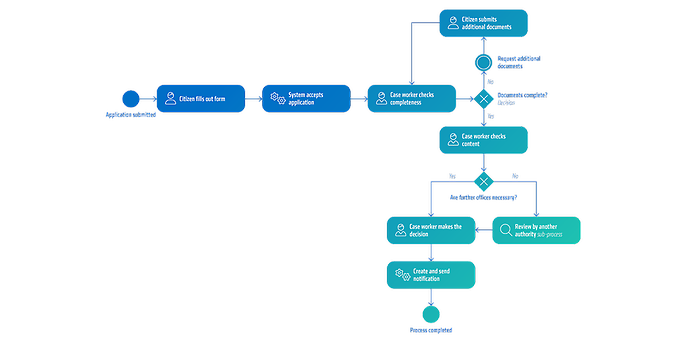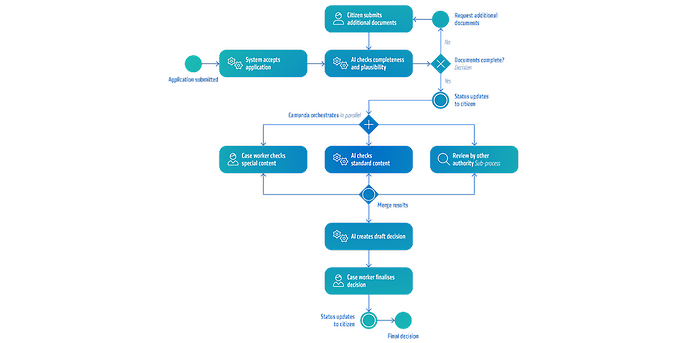27. October 2025 By Christian Broering and Patrick Forche
AI-supported process automation with Camunda: Intelligent administration for the public sector
Rigid regulations and sequential processing steps often make administrative procedures time-consuming processes for citizens and administrators alike. The combination of Camunda with artificial intelligence offers a way out: intelligent automation that takes over routine tasks and applies human expertise where it is really needed.
What is Camunda / Workflow Engine
Camunda is an open-source platform for workflow and decision automation and represents an alternative to classic BPM suites (such as IBM BPM or inubit). In recent years, Camunda has established itself as a tool for companies that want to model, execute and monitor complex business processes. The workflow engine executes so-called BPMN (Business Process Model and Notation) models. BPMN is an international standard that enables business processes to be represented graphically and then executed automatically. Camunda is mainly used for the following reasons:
- Automate end-to-end processes: Camunda is suitable for onboarding, credit checks or invoice approvals, for example.
- Orchestrating systems and people: Camunda controls the flow of information between IT systems and human interactions.
- Creating transparency and monitoring: Customisable views such as dashboards and cockpits enable seamless tracking of process execution.
In short, Camunda combines modelling, automation and monitoring.
How AI supports process automation in the public sector
In public administration, many processes are still heavily influenced by manual activities and rigid rules and regulations. Classic process automation can help here, for example, with the standardised forwarding of forms or the automatic generation of notices. However, as soon as more complex cases arise or decisions depend on different factors, purely rule-based systems quickly reach their limits.
Artificial intelligence can significantly expand these possibilities. AI-supported automation brings with it the ability to learn from data, recognise patterns and continuously optimise processes. For the public sector, this means that administrative processes become not only faster, but also more flexible and service-oriented. Concrete added value arises particularly in combination with a workflow engine such as Camunda:
- Data analysis and pattern recognition: AI can automatically evaluate application or procedure data to identify bottlenecks and provide forecasts on processing times.
- Automation of routine tasks: Activities such as checking standard forms, reading information from submitted documents or sending interim notifications can be integrated directly into Camunda processes with the support of AI.
- Support for decision-making: In more complex cases, AI provides recommendations based on historical data, while Camunda transparently maps the final decisions in a BPMN model.
- Continuous process optimisation: Process data generated in Camunda can be analysed using algorithms (machine learning). This allows administrative processes to be continuously adapted and made more efficient.
- Document processing: Whether invoices, citizen applications or contracts – AI automatically recognises and processes documents, while Camunda triggers the appropriate follow-up action (including approval, additional requests or archiving).
- Generative AI: Even new process models can be created based on natural language, which speeds up the modelling of administrative processes.
This creates a collaboration that is particularly important for the public sector: while Camunda ensures transparency, traceability and compliance, AI provides the necessary intelligence and flexibility to not only automate administrative processes, but also make them future-proof.
Case study: Application procedures in the public sector: What AI and Camunda can change
Typical challenges in application procedures include multiple enquiries, repeated submission of documents and longer processing times. This problem is exemplified by business registrations and other administrative procedures. With the Online Access Act (OZG) and its successor OZG 2.0, online forms are available and end-to-end digitisation is enshrined in law. Nevertheless, the same challenges often remain. Incomplete applications lead to delays, coordination between offices is unstructured, and transparency regarding processing status remains limited. The reason for this is that many digital procedures replicate analogue processes one-to-one without rethinking the underlying workflows.

Klassischer Verwaltungsprozess als BPMN-Diagramm
The universal administrative pattern
Whether it's a business registration, housing benefit application or building permit – application procedures usually follow the same pattern: fill out the form, submit the documents, check that everything is complete, involve other departments, make a decision, send out the notification. The challenges are often identical: applicants are unsure which documents are required, administrators spend a lot of time manually checking standard information, coordination between departments is unsystematic, and citizens receive no information about the status of their application for long periods of time.
From digital forms to intelligent processes
The combination of AI-supported automation and intelligent workflow control can bring about significant improvements here. Camunda ensures transparency and reliable process control, while AI optimises administrative procedures.
AI in the public sector
Possible applications in everyday government work
More efficient, more citizen-friendly and more future-proof. Learn how AI helps government agencies automate processes, digitise services and create transparency – without losing sight of data protection and governance – in practical use cases and our compact GenAI dossier.
Intelligent application assistance
The AI automatically recognises which documents are required for each type of application and immediately checks submitted documents for completeness. In the event of an error, the AI notifies the applicant, reducing the need for additional requests and relieving the burden on administrators.
Orchestrated process control
Camunda automatically determines all responsible authorities based on the extracted data, taking into account their workload, specialisation and historical processing times. For example, a building application can be forwarded to the building authority and the environmental authority in parallel instead of being processed sequentially. For more complex procedures, the system automatically coordinates all parties involved and asks the following questions, among others: Which checks can be carried out in parallel? Where are there dependencies? Which deadlines are critical?
AI-supported case processing
The AI automatically compares the information with databases, recognises standard cases and flags anomalies for more intensive review. In the case of recurring decision patterns, the system generates decision proposals, which are then evaluated by the case worker. This reduces the workload for routine tasks and frees up capacity for complex individual cases.
Proactive transparency
Citizens receive continuous status updates such as ‘Your application has been received in full’, ‘Review by department X is in progress’ or ‘Statement from authority Y has been requested’. This transparency reduces queries and builds trust.

KI gestützter Verwaltungsprozess als BPMN-Diagramm
The result: genuine end-to-end digitalisation
While the Online Access Act (OZG) created digital access, the combination of AI and Camunda enables the next step: intelligent, orchestrated end-to-end processes. For citizens, this means shorter processing times, fewer queries and greater transparency. Administrative staff have the capacity to perform more demanding tasks. Overall, this gives public administration the opportunity to increase its performance and service orientation.
Challenges
The combination of Camunda and AI not only brings advantages, but also presents concrete challenges that need to be overcome:
- Data quality: High-quality training and runtime data is required.
- Traceability: BPMN is a transparent tool, but AI decisions are often black-box decisions, which makes it difficult to make adjustments to the process model.
- Model uncertainty: AI often provides probabilities instead of concrete answers. This must be taken into account in BPMN processes, for example through escalations or human approvals.
- Error and exception handling: Fallbacks or manual checks must be implemented to deal with incorrect AI results.
- Governance and compliance: It must be ensured that the use of AI complies with legal and regulatory requirements.
These are key challenges that need to be addressed. Those who are aware of this can create processes that are both structured and deterministic, yet also able to respond adaptively to complex situations.
Conclusion
In conjunction with Camunda, AI can create significant added value. Camunda ensures clear processes with traceability and orchestration, while AI adds a flexible, adaptive component that prepares decisions based on process data. Case workers can track the decision-making paths of the process at any time and make the final decisions based on the AI suggestions. This combination creates efficiency gains, legal certainty and competitive advantages. The example shows how this added value can look in practice. In the future, further application scenarios will emerge – from insurance claims to the processing of visa applications.
Citizens can experience a modern, more transparent public administration. The expertise of case workers is used where it is needed. The public sector can thus increase its efficiency and improve its reputation among citizens by becoming a service-oriented provider.
The interaction between Camunda and AI is therefore an important step towards intelligent process automation.
We support you!
We show you how the combination of Camunda and AI automates routine tasks, relieves administrators and enables true end-to-end digitisation. We support you in intelligently orchestrating processes in the public sector, improving data-based decisions and sustainably increasing service quality.


